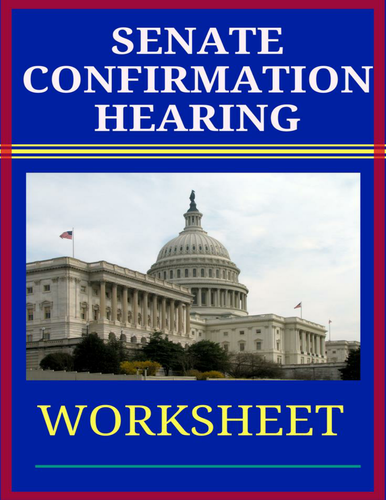
Instructions, lesson plan, and easy to use worksheet to help students track information and analyze the proceedings of the Senate during confirmation hearings for cabinet posts and Supreme Court justices. Helps teachers easily use video primary source footage in government, current events, and U.S. history classes!
The Nitty-Gritty
Here's how this Senate confirmation hearing worksheet works:
• Students are asked to fill out the nominee, the position sought, the hearing context (full Senate? Specific committee instead?) and the date of the hearing.
• Students wait for a question, then summarize it briefly.
• Students determine if the question is fair to the nominee, and also if it is a valid question -- one which is appropriate to ask. They simply check off yes or no to this issue, since minimal writing means more attention can be paid to listening to the video feed.
• Students listen to the nominee's answer and decide if they think the nominee should or should not be confirmed based on that single answer.
• Students write comments as needed to explain their perspectives about questions or answers.
That's all there is to it!
A Class Lesson Plan for Watching a Confirmation Hearing
My own usage of the worksheet looks approximately like this:
• Briefly orient students to activity. Pass out worksheets.
• Watch approx. 30 minutes of a confirmation hearing while students view with me and fill out their worksheets.
• During the 30 minutes, hit pause or mute on the hearing as needed to clarify points for the class or ask them for feedback. After an interesting Q&A (typically 8 or 10 minutes of coverage), I might debrief with the class before resuming. On the other hand, I might wait until the 30 minutes are over and then debrief the students.
• To debrief, I ask questions like this: Who thought the question wasn't fair or valid? Explain why you think that.... Who would confirm the nominee based on the last answer? Why? Who would refuse to confirm? Why?
• I've found in my years of teaching that students in government really want to discuss issues and put forth their own views. When we debrief a confirmation hearing, I usually get a lot of participation and engagement, sometimes even from students who don't usually volunteer to speak in class!
The Nitty-Gritty
Here's how this Senate confirmation hearing worksheet works:
• Students are asked to fill out the nominee, the position sought, the hearing context (full Senate? Specific committee instead?) and the date of the hearing.
• Students wait for a question, then summarize it briefly.
• Students determine if the question is fair to the nominee, and also if it is a valid question -- one which is appropriate to ask. They simply check off yes or no to this issue, since minimal writing means more attention can be paid to listening to the video feed.
• Students listen to the nominee's answer and decide if they think the nominee should or should not be confirmed based on that single answer.
• Students write comments as needed to explain their perspectives about questions or answers.
That's all there is to it!
A Class Lesson Plan for Watching a Confirmation Hearing
My own usage of the worksheet looks approximately like this:
• Briefly orient students to activity. Pass out worksheets.
• Watch approx. 30 minutes of a confirmation hearing while students view with me and fill out their worksheets.
• During the 30 minutes, hit pause or mute on the hearing as needed to clarify points for the class or ask them for feedback. After an interesting Q&A (typically 8 or 10 minutes of coverage), I might debrief with the class before resuming. On the other hand, I might wait until the 30 minutes are over and then debrief the students.
• To debrief, I ask questions like this: Who thought the question wasn't fair or valid? Explain why you think that.... Who would confirm the nominee based on the last answer? Why? Who would refuse to confirm? Why?
• I've found in my years of teaching that students in government really want to discuss issues and put forth their own views. When we debrief a confirmation hearing, I usually get a lot of participation and engagement, sometimes even from students who don't usually volunteer to speak in class!
Something went wrong, please try again later.
This resource hasn't been reviewed yet
To ensure quality for our reviews, only customers who have purchased this resource can review it
Report this resourceto let us know if it violates our terms and conditions.
Our customer service team will review your report and will be in touch.
$3.00
